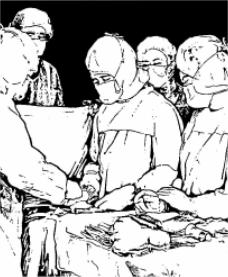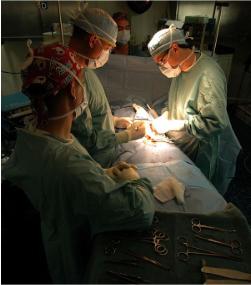|
Lesson 2: Operating Room Care of the Surgical Patient
Section I. INTRODUCTION
The patient undergoing surgery is the center of attention and all activity is focused on him in the operating room for the repair, correction, or relief of a physical ailment. Even though the patient may appear to be in good health and in for a minor operative procedure, he still may experience both physical and psychological stress just as a patient in for a major, more detailed procedure. The patient may be drowsy from the preoperative medication, but is aware of the sights and sounds around him. Reassurance is given not only verbally, but also by facial expression, manner, and a touch or warm grasp of the hand. It is important that events be explained as they happen. There is no operative procedure, even the most simple, that is without risk. The patient should never be left alone while waiting for the surgical procedure to begin. This lesson will include events, people, and procedures that may occur during the operative phase.
a. Ablative Surgery. Surgery performed to remove a diseased organ or other tissue.
b. Biopsy. The removal and examination of tissue from the living body.
c. Constructive Surgery. Surgery to repair a malformed organ or tissue.
d. Elective Surgery. Surgery performed for a person's well-being, but not absolutely necessary for life.
e. Exploratory Surgery. Surgery performed to confirm the extent of the pathologic process and sometimes to confirm a diagnosis.
f. Frozen Section. A technique used in biopsy procedures where tissue specimens are removed from a patient with a microtome, are rapidly frozen, and then examined for a possible malignancy.
g. Palliative Surgery. Surgery performed to relieve the symptoms of a disease process; for example, removal of portions of a cancerous brain tumor which will help relieve a patient of some symptoms, but will not lead to a cure because total removal is not possible.
h. Reconstructive Surgery. Surgery performed to repair tissues whose function or appearance is damaged; for example, plastic surgery.
2-3. SURGICAL TEAM
Nowhere is a smoothly functioning team of more importance to the patient than in the operating room. Respect for others' expertise, the ability to work harmoniously, and the art of communicating effectively are necessary ingredients for a well-functioning team. Each surgical procedure will dictate the number of members on the surgical team; however, there are at least four members as a minimum. They are the surgeon, the anesthesiologist/anesthetist, the scrub nurse, and the circulating nurse (see Figure 2-1.)
|
|
|
2-4. KEY MEMBERS OF THE SURGICAL TEAM
a. Surgeon. The surgeon is the leader of the surgical team and has the ultimate responsibility for performing the surgery in an effective and safe manner. He is dependent upon other members of the team for the patient's emotional well-being and physiologic monitoring.- b. Anesthesiologist/Anesthetist. The anesthesiologist/anesthetist must be constantly aware of the surgeon's actions. He must do every thing possible to ensure the safety of the patient and reduce the stress of the operation.
- (1) Anesthesiologist. The anesthesiologist is a physician who is trained in the administration of anesthetics.
- (2) Anesthetist. The anesthetist is a registered professional nurse who is trained to administer anesthetics.
(3) Responsibilities. The responsibilities of the anesthesiologist and the anesthetist include:
(a) Providing a smooth induction of the patient's anesthesia in order to prevent pain.
(b) Maintaining satisfactory degrees of relaxation of the patient for the duration of the surgical procedure.
- (c) Continuous monitoring to the physiologic status of the patient, to include oxygen exchange, circulatory functions, systemic circulation, and vital signs.
- (d) Advising the surgeon of impending complications and independently intervening as necessary.
c. Scrub Nurse (or Scrub Assistant).
- (1) The scrub nurse or scrub assistant prepares the setup and assists the surgeon by passing instruments, sutures, etc.
- (2) In the Army, the operating room specialist (91D) will often help to fill this role.
d. Circulating Nurse.
- (1) The circulating nurse is a professional registered nurse who is free to obtain supplies, answer the anesthesiologist/anesthetist requests, deliver supplies to the sterile field, carry out the nursing care plan, etc.
- (2) The circulating nurse does not scrub or wear sterile gloves or gown.
- (3) The circulating nurse is the professional nurse liaison between scrubbed personnel and those outside of the operating room.
- (4) Responsibilities of the circulating nurse include:
- (a) Providing for psychological comfort of the patient prior to and during induction of anesthesia.
(b) Making initial assessment of the patient and continued monitoring.
(c) Saving all discarded sponges; during surgery, participates in the sponge count to ensure that no sponge is left in the patient.
- (d) Observing the surgical procedure and anticipating the needs for equipment, instruments, medications, and blood units.
- (e) Preparing labels for the patient specimens for their submission to the laboratory for analysis.
Section III. THE ANESTHETIC AGENT
2-5. FACTORS THAT EFFECT THE SELECTION OF AN ANESTHETIC AGENT
- a. The preoperative patient is usually interested in and concerned about the anesthesia that he will receive. He has probably heard a lot of negative talk from family, friends, and the news media about anesthesia and has usually formed an opinion as to the good or bad points of various methods in use. It is strongly advised that the anesthesiologist/anesthetist and the operating room nurse make a preoperative visit to the patient. This visit will help to allay many of the fears that exist in the patient's mind, will help in building confidence, and will enable the patient to recognize familiar faces in the operating room.
- b. Before surgery, the anesthesiologist/anesthetist reviews the patient's chart, evaluates the laboratory data and diagnostic studies, verifies the surgical procedure, examines the patient, and discusses the option for anesthesia and the attendant risks. The following factors are important in selecting an anesthetic agent:
- (1) Type of surgery.
- (2) Depth and extent of anesthesia required.
- (3) Anticipated length of the procedure.
- (4) Patient's condition.
- (5) Patient's previous experiences with anesthesia.
- (6) Preferences of the anesthesiologist/anesthetist and the patient.
- (7) Available equipment.
- (8) Skill of the anesthesiologist/anesthetist.
- (9) Age of the patient.
2-6. FACTORS CONSIDERED WHEN SELECTING AN ANESTHETIC AGENT
The anesthesiologist/anesthetist must consider the following factors when selecting an anesthetic agent.
- a. Smoking and drinking habits of the patient.
- b. Presence of diseases that effect the:
- (1) Pulmonary function/exercise tolerance.
- (2) Hepatic function (the liver is involved in removal of most agents).
- (3) Renal function.
- (4) Cardiovascular function.
- c. Medication history (medications that the patient is currently taking).
2-7. CLASSIFICATION OF ANESTHETIC AGENTS
As mentioned in Lesson 1, anesthesia is a partial or complete loss of sensation, with or without loss of consciousness, as a result of a disease, an injury, or administration of a drug. Inhalation anesthesia has been classified as the most popular because of its controllability. The intake and elimination of the agent is, in large measure, affected by pulmonary ventilation. The three classifications of anesthetic agents are general, regional or block, and local.
a. General Anesthetic.
(1) Definition. Produces loss of consciousness and thus affects the total person.
(2) Routes of administration.
(a) Inhalation.
(b) Intravenous injection.
(c) Rectal (not used very much in today's practice).
(3) Characteristics of the ideal general anesthetic.
(a) Produces analgesia.
(b) Produces complete loss of consciousness.
(c) Provides a degree of muscle relaxation.
(d) Obtunds reflexes.
(e) Is safe and has minimal side effects.
NOTE: No single anesthetic meets all these criteria. A combination of several agents is usually used to obtain the optimal effects of each and decrease likelihood of toxicity.
(4) Uses of general anesthesia.
- (a) Major head and neck surgery.
- (b) Intracranial surgery.
- (c) Thoracic surgery.
- (d) Upper abdominal surgery.
- (e) Upper and lower extremity surgery.
b. Regional or Block Anesthetic.
- (1) Definition. Anesthetizes large regions of the body.
- (2) Types.
- (a) Spinal/subarachnoid. Anesthetic is injected into the cerebral spinal fluid (CSF) in the subarachnoid space; anesthetics from the umbilicus downward.
- (b) Epidural block. Anesthetic is injected into the epidural space; anesthetizes from the umbilicus downward.
NOTE: The choice of using a spinal/subarachnoid anesthetic versus an epidural block is based on the factors stated in paragraph 2-5.
(c) Axillary block. Used to anesthetize an upper extremity.
c. Local Anesthetic.
(1) Definition. Administration of anesthetic directly into the tissues.
(2) How used. Local anesthetic can be injected intradermally or applied topically to the mucous membranes in the nasopharynx, mouth, vagina, and/or rectum.
Section IV. REASONS FOR SURGERY
There are many reasons for surgery and many kinds of operations. Nevertheless, surgery may be classified as elective, urgent, or emergency.
- a. Elective surgery is surgery that the patient chooses to have. It is performed for his well being, but is not absolutely necessary. In elective surgery, the physician and patient agree on a time for the surgery. It could be scheduled one day or six months in advanced. For example, a mother with four school children wants to have a face-lift. She will probably schedule her surgery during the summer months when the children are out of school.
- b. Urgent surgery is essential for health, such as the removal of an inflamed appendix. Urgent surgery is always essential, but not always an emergency. Another type of urgent surgery is breast surgery for a malignancy.
- c. At the other extreme is emergency surgery. This surgery is unscheduled and is done immediately to save a patient's life or limb. The need for this type of surgery is sudden and unexpected. Bullet wounds, stabbings, and car accidents often require emergency surgery.
2-9. REASON FOR SURGERY VARIES
Some of the reasons why surgery is performed are given below.
- a. To obtain tissue for examination. This enables the surgeon to confirm a diagnosis.
- b. To visualize internal structures during diagnosis. This is frequently performed to determine the extent of a pathologic process and sometimes to confirm a diagnosis.
- c. To cure a disease by removing the diseased tissue or organs, such as an inflamed appendix.
- d. To repair or remove traumatized tissue and structures. This type of surgery is performed to repair a congenital malformation; for example, the repair of a harelip.
- e. To relieve symptoms by means of palliative procedures. This type of surgery is performed to relieve symptoms of a disease process. For example, an intestinal bypass would be performed to relieve the symptoms of intestinal obstruction.
- f. To improve appearance by cosmetic procedures. This type of surgery is performed to restore function or normal appearance to damaged tissues; for example, a facelift.
- g. To perform prophylactic procedures. This type of surgery is performed as a preventive measure; for example, removal of precancerous lesions such as a hairy mole.
The Brookside Associates Medical Education Division is dedicated to the development and dissemination of medical information that may be useful to medical professionals and those in training to become medical professionals. This website is privately-held and not connected to any governmental agency. The views expressed here are those of the authors, and unless otherwise noted, do not necessarily reflect the views of the Brookside Associates, Ltd., any governmental or private organizations. All writings, discussions, and publications on this website are unclassified.
© 2007 Medical Education Division, Brookside Associates, Ltd. All rights reserved

